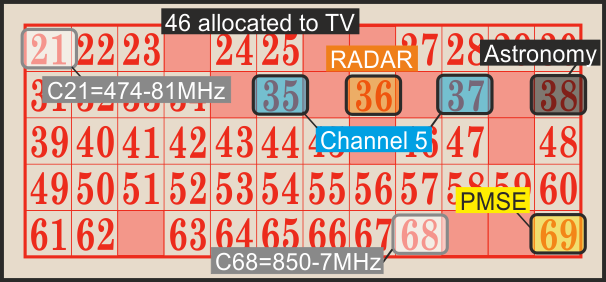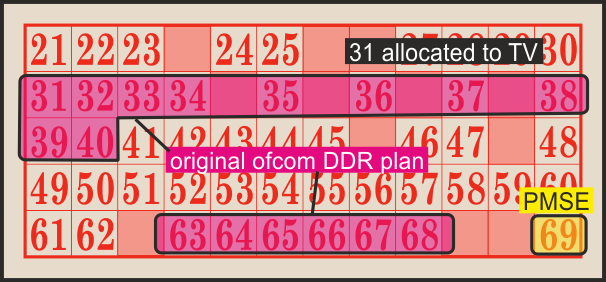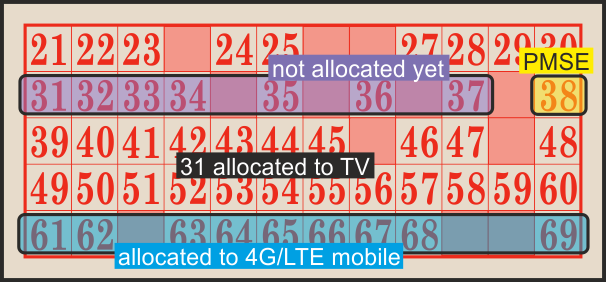Freeview 2020 vs 4G mobile - play Ofcom channel bingo
 Brian Butterworth published on UK Free TV
Brian Butterworth published on UK Free TV Since the launch of "625 line" UHF television, broadcast television services in the UK have used a range of frequencies running from 474MHz to 867MHz, each in blocks of 8MHz.
To make the allocations easier to understand, they have been allocated "channel numbers" starting at C21 and ranging up to C69.
For around four decades the official allocations provided these channel numbers to the BBC, the ITV companies, then Channel 4 (or S4C in Wales) and eventually Channel 5 to provide analogue television services. The following "bingo card" shows the allocations are they were from the 1960s to the millennium.

As you can see, C36 was used for RADAR, C38 for radio astronomy, and C69 was used for "programme making and special events" (PMSE), which generally means the low-power radio equipment used at outside broadcasts.
In the late 1990s, low-power terrestrial digital television launched (as ONdigital, then ITV Digital), these services were squeezed into the existing plan in the UK.
When Freeview became a consumer success, it was decided that the analogue services would be switched off and replaced with just high-powered digital services. As part of this there would be a "digital dividend review" because the digital-only plan would free up some of the TV frequencies, as digital channels can co-exist more efficiently than the outdated analogue TV could. The plan looked like this:

However, it became clear during early 2009 that the 790-862 MHz frequencies would be co-ordinated over the whole of Europe for fourth-generation mobile broadband (Digital Dividend - changes to the 800MHz ). These new mobile broadband services are referred to as "4G" and "Long Term Evolution" (LTE). This left the plan as we find it today:

One of the effects is that some transmitters in switched-over regions are moving services from C61 and C62 into next year - 2013 - post-switchover changes to Freeview transmission frequencies.
What does the future hold? Part two: Ofcom channel bingo II - introducing the bands
9:31 PM
Ian: Satellite has its fair share of complications. With so many different orbital positions being used by the countries that transmit free-to-air services it requires a receiver that supports Diseqc to switch between the LNBs. That is in addition to every tuner needing a cable back to the LNB. Then do you run the receiver in Non-Freesat mode to get all the available channels, or go for the EPG then fiddle about tuning in all the extras that Freesat don't give you, (like Sky News!) It makes diplexing a second aerial to receive the Freeview COM muxes sound easy.
| link to this comment |
11:13 PM
I was reading the Guardian piece on 4G interference. Freeview homes face digital TV interference due to new mobile services | Media | guardian.co.uk
It mentions that those within 2KM of a 4G mast will be affected. Surely that distance is inaccurate? I'm certain I read a piece previously that it was going to be somewhere in the region of 400m. Does anyone know the exact situation? (AL35RQ)
| link to this comment |
12:32 AM
@Briantist: The end of this excellent article promises "Part two follows tomorrow."
Did that appear, cos I haven't been able to find it?
| link to this comment |
woodface: Sorry, I was a bit off-colour and didn't post it for a few days - Ofcom channel bingo II - introducing the bands | ukfree.tv - independent free digital TV advice and Ofcom Bingo III - compatibility or improvements?
| ukfree.tv - independent free digital TV advice have the last two parts.
| link to this comment |
TheLegend: As it says, I think, in the post I wrote back in 3rd June 2011, Ofcom moves to protect Freeview interference from 4G mobile devices | ukfree.tv - independent free digital TV advice - the problems locations are a function of
a) how close you are to the 4G mast
b) how far you are from your Freeview transmitter;
c) if you use boosters or amplifiers in your system.
So, if you have an amplifier and you're close to the 4G transmitter and you're on the fringes of Freeview reception, you may have to take action.
I have spoken to people who have been modelling this and I think the answer to the question of "who will be effected" is "it's more or less random".
| link to this comment |
9:55 AM
Why place 4G so close to Freeview frequencies?
Why so many expensive Freeview transmitters?
Why not have everyone on satellite reception?
A baffled technician and Radio Ham.
| link to this comment |
What about 5G, 6G etc; where are they going to go?
Or is the frequency plan to keep getting changed every five or ten years? That is, we make a plan and then in a few years time it is (partly) torn up and re-written and therefore many people incur additional expense and inconvenience.
At the end of the day, where a plan is made, it should be stuck to and not changed simply because we are unable to think any further ahead.
| link to this comment |
12:33 PM
Dave Lindsay: We are now in a situation where technology is changing so fast that there does not seem to be any answer to the problem of constantly having to buy new equipment. Some people moan about needing a new Freeview box or a new aerial every few years, but happily accept a situation where a new mobile phone is needed every couple of years or a computer costing hundreds of pounds is required to use BBC i-player because the BBC have decided to make it no longer compatible with IE6 or older windows systems. I sometimes wonder if the planners were already aware of plans to use more spectrum for 4G, but delayed the transfer of transmission of the COM muxes in group A because DVB-T2 would need to be employed and too few people have the necessary receivers at present.
| link to this comment |
KMJ,Derby: I'm thinking from the point of view of frequency planning. The plans keep getting changed and thereby force some to take action by changing their aerials in order to continue receiving TV.
The fact that there will be further generation mobile services in the future is surely a given. So where might they go? When might GSM be turned off, and therefore the frequencies thrown free for later generation services?
Am I right in understanding that the reason that the 800MHz frequencies are needed because 3G only uses the 2100 band and that this doesn't provide as good a service due to higher frequencies not travelling as well (walls attenuating signals etc)?
| link to this comment |
1:05 PM
Len Dixon: The planners are so keen to utilise every possible bit of spectrum that it is inevitable that frequencies are used close to those of broadcast transmitters. It is somewhat alarming that there is talk of trying to use frequencies in between those of the TV and radio transmitters in areas where there is any space. What will the band II (FM) frequencies be used for after transfer of national and regional radio to DAB? It is fair to say that Freeview is a more user friendly system and is very cost effective in built-up areas. In fact satellite transmission would need terrestrial back up in urban areas to achieve the same penetration as the current Freeview network. I think it was more of a political rather than practical decision to convert every relay to digital rather than utilise satellite in the more remote areas. The question of 4G interference is really one of viewers needing aerial systems that incorporate good quality screened cable (including fly leads), and as a first line of defence using a group A or K aerial in those areas where this is appropriate to give best possible gain on the required frequencies. Manufacturers of masthead amplifiers could produce a range that incorporate a suitable filter, removing the need for additional equipment to be fitted to viewers installations.
| link to this comment |